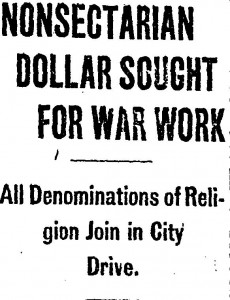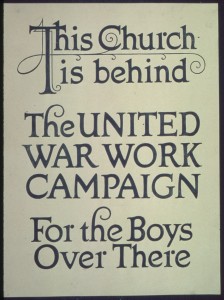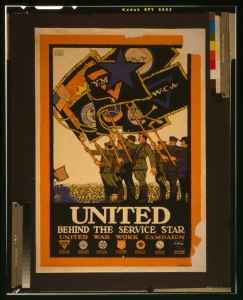Introduction

As a campaign comprised primarily of religious organizations, the United War Work Campaign was highly influenced by the contemporary religious environment. The very idea of the campaign was inherently rooted in the moral uplift of the age and the belief that social ills could be combated by organized intervention. Religious concerns about temperance and personal moral hygiene provided the imperative impetus for the groups’ participation in camp recreation and the policing of ill-influences on the men.
Furthermore, religious identity shaped the conduct and reasoning of the individual groups involved in the campaign. Both the Catholic and Jewish organizations were only admitted to work the Commission on Training Camp Activities when the YMCA refused to allow non-Protestants into their war work.[1] Divisions also existed within the religions themselves – Catholic laity and Catholic hierarchy, Reform and Orthodox Judaism, and liberal Protestantism and evangelical Protestantism.
Industrialization and Immigration
The religious motivations of the groups involved were also shaped by two dominant developments of the country since the Civil War: industrialization and immigration. The decades between 1865 and 1917 were America’s “coming of age” in terms of industrial production. The demand for labor in manufacturing businesses drew workers to the cities, causing massive urbanization, hitherto unseen in the country. Religious groups in America, regardless of denomination, could not disregard this new social order and its effects: urbanization, social stratification, poor housing conditions for the urban poor, and municipal corruption. Many figures later involved in the United War Work Campaign had been active in reform efforts centered on industrialization and urbanization – Cardinal Gibbons actively promoted worker’s rights; Raymond Fosdick investigated the problem of policing in America in comparison to Europe; Patrick Henry Callahan devised a profit-sharing initiative with the employees at his varnish company; the YMCA reached out to urban youth in an attempt to keep them on “the straight and narrow”; and the Salvation Army sought to mitigate the harshness of lower-class urban life among the very poorest of the poor.[2]
Religious Divisions and “Hyphenated Americans”

Long established religious bodies in America were disrupted by a new wave of immigration from southern and eastern Europe in the decades around the turn of the century. (See Immigrants and Ethnicity) Reformed Jews now had orthodox brethren within their religious community, while the Catholic community had to deal with different ethnic churches within local communities (i.e. the Irish Church, the Polish Church, the Italian Church, etc.). This proved intensely problematic for the Catholic Church in particular – while most orthodox Jews were content to remain within their insular communities, the various national and ethnic loyalties of the new Catholic immigrants hampered Church’s endeavors to prove its loyalty to the United States – a loyalty that had always been in question thanks to longstanding Protestant mistrust of “papists.”[3]
These loyalties proved even more problematic when the United States entered World War I. President Wilson made no secret of his mistrust of “hyphenated Americans” (i.e. citizens with loyalty to political entities other than America), and during the war there was great pressure, sometimes even from within ethnic communities, to conform or “Americanize,” as old fears of a “foreignized” nation were given a new and more plausible basis in the need for national unity.
Religious Pluralism and the United War Work Campaign
When confronted by the heterogeneousness of American religion, the organizers and promoters of the campaign turned to nonsectarian language to appeal to members of all faiths. Wilson himself advocated religious cooperation between all groups involved as the best course of action. “It is my judgment, therefore, that we shall secure the best results in the matter of the support of these agencies, if these seven societies will unite their forthcoming appeals for funds, in order that the spirit of the country in this matter may be expressed without distinction of race or religious opinion in support of what is in reality a common service,” he remarked in a letter to Fosdick on September 3, 1918.[4]
This spirit of pluralism was reflected in other advertisements for the campaign. A Chicago Tribune article from November 10, 1918 declared that the motto of the campaign in the city was “A dollar knows no religion; it works for all.”[5] The War Cry, the Salvation Army’s periodical, announced the Army’s participation in the campaign by quoting one speaker from a war workers conference: “We are not Protestants or Catholics, Gentiles or Jews, bond or free, but we are Americans!”[6] “Thank God the walls of denominationalism and religious prejudice are crumbling to the ground!” the War Cry gushed in celebration of this speaker and the United War Work Campaign. [7] Another War Cry article piece about the campaign began, “In Christ Jesus there is neither Jew or Gentile.” [8]The fact that the Jewish Welfare Board, the Salvation Army’s compatriots in the campaign, did not believe in the divinity of Christ apparently was not considered by The War Cry; rather, the cooperation of the organizations was all that mattered.

Even though five of the seven organizations were religious, posters and advertisements for the campaign almost never used religious imagery in order to highlight the supposed unity of the different groups. Viewers were reminded that the different organizations were not of the same creed and were cooperating for the good of America’s servicemen, but crosses, Stars of David and rosaries rarely appeared in the United War Work Campaign’s advertisements. Consider the poster in Figure 3. All seven organizations are depicted standing in unity. “United” is the largest word on the image. Religious imagery is present on the individual flags flying, such as the Star of David on the Jewish Welfare Board’s flag and the cross on the crest of the National Catholic War Council. However, “the service star” is in the foreground and these religious symbols are in the background. The embodiments of all seven organizations are also seemingly in ranks and are all focused in the same direction, implying a common goal. As shown in other pages, these groups were not always so unified in purpose and creed, but the façade of religious cooperation and coexistence was pivotal to the campaign’s public image.
[1]Raymond Fosdick, Chronicle of a Generation: An Autobiography (New York: Harper and Brothers Publications, 1958), 149.
[2]Edwin Gaustad and Leigh Schmidt, The Religious History of America (New York: HarperCollins Publishers, 2002), 231-234, 241-243, 252; Fosdick, Chronicle of a Generation, 124; William E. Ellis, “Patrick Henry Callahan: A Maverick Catholic and the Prohibition Issue,” The Register of the Kentucky Historical Society 92, no. 2 (Spring 1994): 175-176.
[3]Gaustad and Schmidt, Religious History of America, 209-212
[4]Speech Stuff Concerning the Y.M.C.A. for Use in the United War Work Campaign. ([New York? :, 1918), http://hdl.handle.net/2027/nnc2.ark:/13960/t7pp1q326.
[5]“NONSECTARIAN DOLLAR SOUGHT FOR WAR WORK: All Denominations of Religion Join in City Drive.,” Chicago Daily Tribune (1872-1922), November 10, 1918.
[6]“Salvationists Participate in New York Conference of War Workers,” The War Cry, October 12, 1918, no. 1932, Reel 21, Microfilm Reading Room, Library of Congress, Washington D.C.
[7]“Salvationists Participate in New York Conference of War Workers,” The War Cry, October 12, 1918, no. 1932, Reel 21, Microfilm Reading Room, Library of Congress, Washington D.C.
[8]“Carnegie Wall Demonstration Puts Salvation Army in War Fund Drive Strongly,” The War Cry, December 7, 1918, no. 1940, Reel 21, Microfilm Reading Room, Library of Congress, Washington D.C.